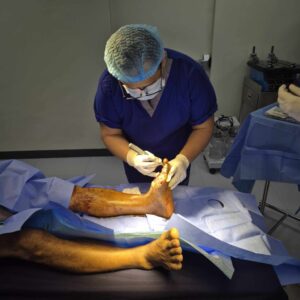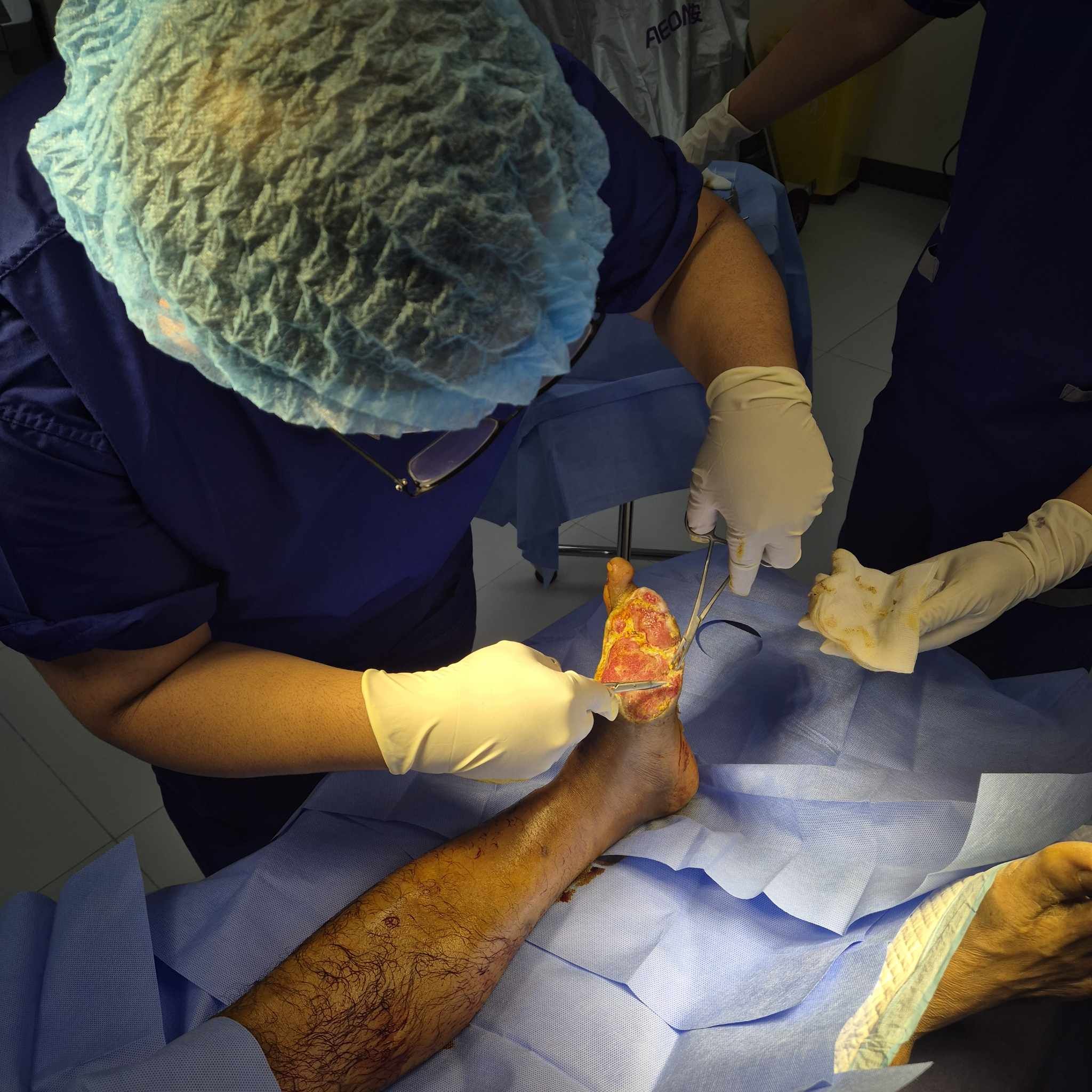Debridement Services play a crucial role in helping patients recover from chronic, infected, or slow-healing wounds. Many people struggle with wounds that refuse to improve due to trapped dead tissue, bacteria, or severe inflammation. These issues can delay healing and increase the risk of complications. Debridement Services address these challenges by clearing damaged and infected tissue, giving healthy skin the best chance to recover. Patients who receive this type of care often experience improved healing speed, better comfort, and lower risks of infection. Modern wound care clinics provide highly precise methods, including advanced tools that support faster and safer tissue removal. With proper Debridement Services, patients gain access to systematic and professional care designed to restore healthy tissue and support long-term healing.
Understanding Debridement Services
Debridement Services are medical procedures designed to remove non-viable tissue from wounds that fail to heal properly. When a wound contains dead or infected tissue, the body’s natural healing process becomes slower and less efficient. This environment also encourages bacteria to multiply, raising the likelihood of infection. Debridement Services aim to remove these barriers so the skin can regenerate effectively. Patients often require these procedures for diabetic ulcers, pressure sores, traumatic injuries, and surgical wounds that struggle to heal normally. Proper evaluation determines which debridement method matches the patient’s wound condition, ensuring safety and precision. Without professional Debridement Services, chronic wounds may worsen, leading to complications that affect mobility, comfort, and overall health.
Types of Debridement Services Offered in Professional Wound Care
Modern wound care clinics provide several forms of Debridement Services tailored to different wound types. Each method offers specific benefits depending on the severity of tissue damage.
Surgical Debridement
Surgical Debridement Services involve the direct removal of dead or infected tissue using precise medical instruments. This method is recommended for patients with deep tissue damage, severe infection, or large sections of necrotic tissue. Trained specialists perform this procedure to ensure accuracy and control while preparing the wound for proper healing.
Ultrasonic Debridement
Ultrasonic Debridement Services rely on soundwave-based equipment that breaks down dead tissue without harming healthy skin. This technique offers improved comfort and precision. It is especially useful for chronic wounds that require gentle but effective tissue removal. Many clinics prefer this method for its accuracy and patient-friendly approach.
Enzymatic Debridement
Enzymatic Debridement Services use topical agents that naturally dissolve necrotic tissue. This approach is ideal for patients who cannot tolerate surgical or mechanical methods. It is frequently used for wounds that require gradual tissue removal.
Autolytic Debridement
Autolytic Debridement Services involve moisture-retaining dressings that help the body’s natural enzymes soften and break down dead tissue. This method works best for mild to moderate wounds that are not heavily infected. It is a gentle and effective choice for long-term wound management.
Mechanical Debridement
Mechanical Debridement Services include wound irrigation and dressing techniques that remove unwanted tissue through controlled physical action. This method is suitable for specific wound types that benefit from a steady and systematic approach to tissue removal.
Who Can Benefit from Debridement Services
Debridement Services are essential for individuals dealing with stubborn wounds that refuse to improve. Patients with diabetic foot ulcers often need these treatments due to poor blood circulation and nerve damage. Pressure sores caused by prolonged immobility also benefit greatly from accurate tissue removal. People with traumatic wounds may require Debridement Services to remove debris or damaged tissue that prevents recovery. Post-surgical wounds sometimes develop areas of dead tissue that slow healing, making professional intervention necessary. Patients with infected wounds also gain significant improvement when necrotic tissue is cleared, allowing antibiotics and dressings to work more effectively.
Step-by-Step Overview of the Debridement Process
Debridement Services follow a carefully planned process that ensures safety and effective results. Every patient begins with a thorough wound assessment to determine the most appropriate treatment method. A wound care specialist examines factors such as tissue depth, skin condition, infection level, and circulation. Once the evaluation is completed, the specialist selects the right debridement technique.
During the procedure, dead or infected tissue is removed using the chosen method, whether surgical, ultrasonic, enzymatic, autolytic, or mechanical. After the tissue is cleared, advanced dressings are applied to protect the wound and support moisture control. Patients may also receive antibiotic therapy when needed to prevent infection. Wound monitoring continues through scheduled follow-ups to track progress and adjust treatment when necessary.
Why Professional Debridement Services Matter
Professional Debridement Services offer significant advantages over home-based wound care. A trained specialist can distinguish between healthy and non-healthy tissue, ensuring that only harmful tissue is removed. Clinics also have access to advanced tools that support precision and comfort. Proper wound evaluation, which is not possible through home remedies, ensures that the chosen method matches the patient’s health condition. Debridement Services also reduce the risk of complications because infected tissue is removed efficiently. Faster healing leads to better mobility, improved comfort, and reduced medical expenses associated with prolonged wound issues.
Benefits of Choosing a Specialized Wound Care Provider
Patients who choose specialists for Debridement Services receive comprehensive and personalized care. Clinics with modern equipment deliver safer and more comfortable treatments. Specialists also create customized plans that support long-term healing through proper wound cleaning, nutrition guidance, and mobility recommendations. Those recovering from diabetic wounds, chronic ulcers, or deep injuries benefit from consistent monitoring and professional treatment adjustments. A dedicated wound care provider also ensures that each patient receives safe, efficient, and reliable support throughout their recovery journey.
Aftercare Tips for Patients Receiving Debridement Services
After receiving Debridement Services, proper aftercare plays a significant role in supporting faster healing. Patients should follow professional guidance on cleaning routines to prevent infection. Proper dressing changes help maintain a clean and safe environment for the wound. Good nutrition rich in protein, vitamins, and minerals supports tissue repair. Patients with foot wounds should choose comfortable and protective footwear to reduce pressure and friction. Regular follow-up visits allow specialists to evaluate the wound’s progress and adjust treatment when needed. These steps help maximize the results of Debridement Services.
Common Myths About Debridement Services
Many people believe that Debridement Services are always painful, but modern techniques greatly reduce discomfort. Another common myth is that wounds will heal on their own without professional intervention. Some patients assume that home remedies can replace medical debridement, which often leads to delayed healing and higher infection risks. Others worry that advanced methods such as ultrasonic procedures are unsafe, even though these techniques are proven to be precise and patient-friendly. Dispelling these myths helps individuals understand the true value of Debridement Services and encourages them to seek proper care when needed.
Signs You Should Visit a Wound Care Specialist
Wounds that fail to show improvement after several days often require Debridement Services. Signs such as foul odor, discoloration, warmth, increased drainage, and swelling indicate possible infection. Individuals with diabetes should pay close attention to foot wounds, as small injuries can worsen quickly. Pressure wounds caused by prolonged sitting or lying should be evaluated immediately if they deepen or grow in size. Traumatic wounds with embedded debris or tissue damage also require professional attention. Early intervention through Debridement Services can prevent complications and support better overall healing.
Debridement Services and Modern Wound Care Technology
Advancements in wound care technology have improved the precision and comfort of Debridement Services. Ultrasonic devices allow specialists to remove necrotic tissue without damaging healthy skin. Modern dressings offer moisture balance and protection, helping wounds heal faster. Clinics equipped with updated tools can provide safer and more efficient treatments. This progress supports patients with chronic or high-risk wounds by reducing their healing time and improving their overall comfort.
Frequently Asked Questions (FAQ)
1. Are Debridement Services painful?
Most methods are designed to reduce discomfort. Clinics often use numbing agents or gentle techniques to keep the patient comfortable.
2. How long does it take for a wound to heal after debridement?
Healing time varies depending on the wound type, size, and patient health. Many patients experience faster recovery once dead tissue is removed.
3. How often should Debridement Services be done?
The frequency depends on the wound’s condition. Some patients require multiple sessions, while others need only one.
4. What types of wounds benefit the most?
Chronic wounds, diabetic ulcers, pressure sores, infected wounds, and traumatic injuries benefit greatly from Debridement Services.
5. Can debridement prevent infection from spreading?
Yes. Removing necrotic tissue helps reduce bacterial growth and allows treatments such as antibiotics to work more effectively.
6. When should someone visit a specialist?
Any wound that worsens, shows signs of infection, or fails to improve should be evaluated by a specialist offering Debridement Services.











